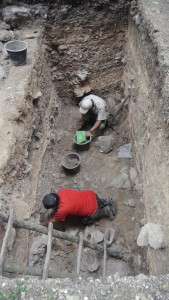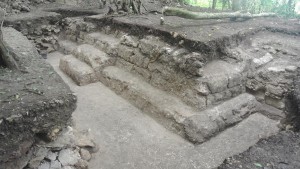The third week of the season was exceedingly cold; Caracol received a cold blast of Artic air that dropped temperatures far below anything normal. This was combined with a drizzle of rain on several days. But, regardless of the climatic conditions, the excavations have still proceeded in the five areas that we are focusing on during this season; the advances made during the week to each excavation area are compartmentalized below and photos may be found at the end of the text. Diane was also here for her initial visit this weekend and left on Tuesday to go back to Orlando; she will be back in 3 weeks.
VIA GROUP (C95E-C95H). The double-group on the eastern side of the Machete Causeway, connected to this roadway by its own little causeway or “via,” has 5 different excavations underway. All are trenches. The northernmost one is Excavation C95G, an axial trench over Structure B115. At this point in time, the humus has been cleared in this excavation and a front step has been defined and drawn. A cache of two urns was found and excavated this week immediately in front of this step. Excavation C95I is an axial trench over Structure B116, which has not yet been started. The other three excavations are all trenches on Structure B118: C95E is a trench over the Protoclassic tomb excavated in 1994. Thus far, two caches and a burial have been recovered from this excavation and this trench has an outset set of facing stones (to the west) that does not occur in the other two trenches into the building. The initial cache was recovered behind this lower facing along with a rounded pedestal foot for an altar. The second cache was located immediately east of the tomb in fill and consisted of two lip-to-lip vessels as well as a set of closed spondylus shells that was placed on other smaller shells and topped with an oyster conglomeration; a pointed bone with notched sides, meant to imitate a stingray spine, was placed within the spondylus shells. East of this was a human burial that had been placed into the structure fill and sealed with a plaster floor; a tree grew right through the body, meaning that it was quite disturbed. The other two trenches into Structure B118 have not produced any formal deposits, only sets of facings. Excavation C95F is on the southern side of the structure and Excavation C95H is axial to the building.
NORTHEAST ACROPOLIS (C117G). The trench into Structure B34 was successfully reopened and new (and deeper) excavations proceeded this week. Excavation recovered a “medicine bottle” in the fill immediately behind the front balk; approximately 30 centimeters lower than this vessel, at the interior base of the front balk and to its southern side, the legs of a burial were recovered that were overlain by a Belize Red dish. Excavation into the center of the trench found well-packed fill for an earlier construction episode in Structure B34 and came down upon a large spondylus shell set horizontally in the fill dirt in the center of the trench. At week’s end, this excavation had exposed the top of an earlier step and was about 60 cm above the 2 m deep plaza floor levels known from earlier investigations.
CENTRAL ACROPOLIS (C205B). This excavation is a continuation of last year’s investigation in the center of the plaza. It is 3 m east-west by 2 m north-south and at week’s end was over 3 m deep. The excavation continues to go through packed fill without finding any formal architectural features. The sherd material that has been encountered all seems to be of Late Preclassic date.
PLATFORM B37 (C206E). The goal of this excavation has been to expose the front of the Preclassic building that was found buried in Platform B37 during the 2015 field season. To this end, an excavation linking the two trenches dug last year was undertaken with an intermediate pause to capture a centerline section. The section (over the stairway) was drawn this week and the rest of the fill was removed from the front of the building. A badly preserved burial was recovered in front of the northeastern portion of the building. In the humus for the section balk, before C207E was joined with C207C, two Terminal Classic line-of-stones were encountered and drawn; then, the section balk was removed. As was encountered last year, the floor east of the buried building has evenly spaced, parallel scribe lines running east-west at the same orientation as the building. The stair is not broad, but projects out into the plaza and is composed of huge limestone blocks, a building feature also noted from the depths of Structure B19. At week’s end, the building and the excavations were largely cleaned, a process that will conclude next week. Also a 3 m by 2 m excavation (C207F) was laid out on the eastern side of the Structure B37 platform in axial line with the western buried building to see if another buried building can be found.
STRUCTURE B38 (C208G). In spite of the rain, this areal excavation continued this week and uncovered a rear construction wall and then a soft limestone rear (west) facing that was set on the floor that runs under the raised building; there is approximately 30 cm between the rear wall and the construction wall where this lower floor was exposed. While the eastern interior part of the building has a rock fill, the western portion that adjoins the construction wall is dirt fill. Excavation here has recovered faunal remains and what appear to be reconstructable utilitarian vessels within the dirt fill against the construction wall.








Great pictures an interesting update. I love seeing the before and after pictures of C207E. It’s amazing what was uncovered in just one week. Hope the weather cooperates for the remainder of your stay.
Sorry the weather was so bad but I’m sure you’re back on. Track. Good luck and happy digging
Everything looks great I hope everybody is great and enjoying yourselves I’m sure you will have a fantastic dig
Miss you Jackie love you
Love daddy
John Rumberger